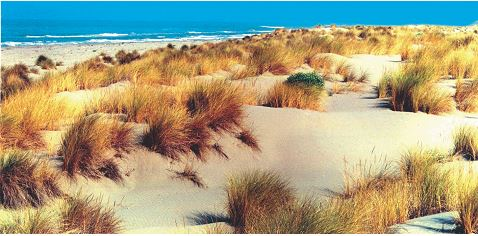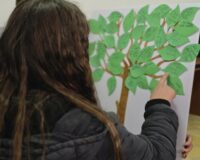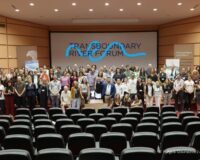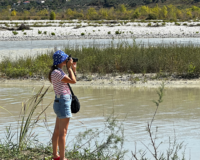Support for the movement: PRO Nartës-JO Naftës
By Prof. A. Miho*
Due to the concern raised by some environmental organizations in the country, we have been made aware these days of the Decision of the National Council of the Territory that grants permission for a well site, called ‘Zvrenec West -1’, dt. 22.07.2015; the decision is preceded by the Environmental Declaration of the National Environment Agency and the Ministry of Environment, dt. 11.06 2015, which, as institutions responsible for the environment, surprisingly give approval in favor, listing a number of supporting arguments (!) and requests. This means that it is allowed to drill a well for oil again in the narrow strip of coastal dunes that separates the Narta lagoon from the sea. I would like to emphasize that the environmental concern stems from the fact that this activity is allowed to take place within the Protected Area, even very close to its strictly protected area, which the Albanian Government itself has declared as such in 2004. And to our surprise this it is not an isolated case today…
From the above, I would like to bring facts, but also to awaken my interest and influence to decision makers, investors, but not only … also to all interested parties to stop and desist from such actions that fall against what we ourselves have sought to protect, but also with our desire for sustainable development, for the development of natural, ecological tourism, etc., often too talked about even by politics itself today…
Briefly on the natural and biological values of the Narta area
The reader can find more information about the values of this area and the entire Albanian coast in our 2013 publication: ‘Between land and sea – Ecoguide to discover the transitory waters of Albania’.

The area from the Vjosa delta to the Narta lagoon includes many habitats with flora and fauna, not only rich, but also special. Over 570 species of high plants and about 70 species of mushrooms are given for the area; over 330 species of microscopic algae have been found in aquatic habitats, with about 95 species in the lagoon plankton. Over 30 plant species and 3 fungi are threatened according to IUCN criteria. About 15 types of plants are considered rare or relic, such as salep, including the Albanian salep (Orchis albanica), water lilies, four-leaf water fern, poetic narcissus, marinas, etc. Many of the plants and the groups they form are also important for the protection of the dunes, the protection from sea erosion, but also the preservation of their charm and relaxing and attractive properties. Here it is worth highlighting the belt of Mediterranean pines, with maritime pine, soft pine, mixed with Mediterranean scrub vegetation, dune vegetation, etc.
It is these diverse habitats (marine, salty, brackish, dune, freshwater or riverine) with this rich and special vegetation that also house a rich fauna. About 198 threatened animal species are given for the area, which is half of the threatened animal species for the entire Albanian territory. In this way, over 60 species of molluscs are known for this entire coastal area, where over 30 species live in the Narta lagoon; the most abundant are gastropods, Hydrobia acuta, Ventrosia ventrosa, Pusillina mariginata, Pirenella conica, Cyclope neritea, and bivalves Cerastoderma glaucum and Scrobicularia cottardi, some of them also have economic importance. The world of insects is not well known, but over 150 species of winged insects have been found in various aquatic habitats. About 9 species of amphibians and 26 species of reptiles are given for the area, most of them threatened and included in the Red list of protected fauna in Albania. Two species of amphibians, Rana balcanica and R. lessonae, have been of economic importance for the area for many years, where several thousand tons are collected for the market every year. Vjosa Delta and Narta are mentioned for the variety of fish, and it is also very important for fishing and aquaculture; about 40 species of fish are mentioned for the area, of which more than 10 species are more economically important for the fishing sector.

But the Narta area ranks second after Karavasta in terms of importance for waterfowl. About 80 bird species are given, where about 10 of them winter in the area, such as ducks, Anas acuta and Bucephala clangula, flamingos, Phoenicopterus rubber, seagulls, Larus audouinii, etc. The most abundant are ducks (Anas spp.) and mallards (Fulica atra), for which up to 18,000 individuals and 13,500 individuals have been counted, respectively. It is even said that during the period 1950-70 the area was populated by over 100 pairs of curly pelicans (Pelecanus crispus), while today this globally threatened bird is a rare visitor to the area. It is worth noting that today due to the disturbance, over 90% of the birds prefer to use the central part of the lagoon and the salt flat, which is somewhat quieter, where even a pair of ‘rebel’ hunters cannot reach, despite the Moratorium of Hunting.
All these data are enough to tell about this natural symphony of the Narta area which is extremely fragile, and unfortunately it has been under threat for years and continues to be so today. It is precisely this reason that “forced” the Albanian Government in 2004 to declare the Vjosë-Nartë area as a Protected Landscape (197 km2; category V according to IUCN criteria). The area is in a very close and reciprocal relationship with the Sazan-Karaburuni Marine National Park (126 km2; category II) declared in 2010. Both of these together are in a functional unity with the Llogora National Park (10 km2), declared as a National Park as early as 1996, as well as with the Rrëza-Karaburun Natural Managed Area (200 km2; category IV), which also includes the Orikum marsh area (8 km2), all announced since 1966 and renewed in 1986. This makes Vlora a particularly important and extremely powerful area for the Natural and Biological values that find shelter within its territory. This is definitely an asset and a good opportunity for economic development, for the development of natural and ecological tourism, in addition to mass summer beach tourism, historical and cultural tourism, for which this whole area is rich. But on the other hand, all this wealth lays forward and requires a lot of responsibility, a lot of prudence and maturity for development, from local and central decision-making…
Why? Where does the work go?
Above I emphasized the word ‘forced’ for the declaration of the aforementioned protected areas; this is because I am convinced that the governments have been little conscious and responsible for the declared protected areas, both in the previous system and today in this system, especially during the entire transition period. Let’s briefly review some of the actions. There was a lot of talk about the Vlora TEC; stubbornly it was built, and with it Petrolifera nearby, both on the edge of the sea and adjacent to the protected area; in 2009, the construction of the TEC was completed, a plant that cost nearly 100 million euros and which, ironically, has not worked for a single day. Now the TEC is kept only as a museum, which makes a difference to the abandoned former Soda-PVC industrial park nearby. There was a lot of talk about the so-called Wind Park, the largest in the Balkans, right in the heart of the protected area of Karaburun. The fact that the Soda forest continues to be threatened by urbanization, leaving all the ruins of the Soda-PVC plant in oblivion, cannot be called wisdom in decision-making. A few years ago, near Narta, there was a failed drilling for oil, and surprisingly, the same thing is persistently coming back! All these do not pass without leaving a mark on the biological quality of the area and its general values. But luckily they await the decisions in silence because they have no mouth to speak. Birds cannot protest, neither can fish, let alone plants. They simply become impoverished, disappear or leave the country, as has happened elsewhere in the country!

There is another fact that should be emphasized about the Narta area. This area is closely connected and dependent on the Vjosë river. All the values of Narta originate and are maintained by the degree of “wildness” of this river, which is unique for all of Europe. We have previously emphasized that environmental organizations with names such as WWF, EURONATUR, RIVERWATCH, etc. in cooperation with governmental and non-governmental organizations in the countries of the Western Balkans region, are making efforts to protect rivers from the epidemic of dam construction for HPPs. Among them, the Vjosë river has special attention, until today it is uninterrupted from the source to the mouth. It is rightly called a wild river and it is requested to be protected as such, not to be interrupted by dams, but to follow the development in a different way with protective and rejuvenating measures, by declaring it a National River Park. This is one of the main objectives in the framework of the campaign ‘Saving the blue heart of Europe’, which has also found support from local non-governmental organizations under the direction of our Environmental Center EcoAlbania, but also from the local government, local and international media, but also of many other friends of the environment in the country and in the region.
In the campaign for Albanian rivers and for Vjosa in particular, we had positive signals from the Government to not allow the construction of dams on the Vjosa river. This hope grew with the stoppage of the Kalivaci dam works, started in 2007. But surprisingly, we hear that the Government with VKM no. 677, dated 29.7.2015, allows the approval of the bonus in the competitive selection procedure given to the company Çinar-San Hafriyat Nakliyat Inşaat Turizm Sanayi Ve Ticaret Limited Company for the concession award of the Poçem hydropower plant. Practically, it is a matter of allowing another dam to be built on the Vjosa, this time in Počem, just a few kilometers below the started Kalivaçi dam! We emphasize that in the hydropower plans there is the possibility of building up to 8 dams along the entire course of the river, from Selenica to Kaludh. A dam was started and abandoned, but not without consequences and without seriously disfiguring the environment of the area. Now begins another dam, for which the end and consequences are unknown! Moreover, in the river branches of the upper course of Vjosa, more than 20 HPPs are under construction or have already been built, concreting and tunneling the waters in really virgin parts, some even within protected spaces (part of the network of areas protected in the Republic of Albania)! All these together are additional pressure on natural values, biodiversity and tourism development in the entire Vjosa basin, including the Narta area, especially the Narta lagoon and the coastal dune belt.
The last advise
I don’t want to politicize the issue at all, but I would like (good) understanding with all those decision-makers, with all those who sign the environmental permits, today to drill for oil, or to build a dam or a river tunnel, even for to build a tourist resort near or within a protected area (so far the work has gone in Albania!!!), and with all those who want rapid development of the country, including investors, that everyone has a responsibility to take care for the country and the country’s assets, that they are the ones who decide the direction that the country and our economy should follow in the future. I or many others who think like me are not against the exploitation of our natural resources. But what is wrong and incites anger is the fact that often in the desire to develop we rush too much (!), in many cases we even behave as arbitrary owners, without taking into account the laws of nature, but also without consulting the requirements, with different roads! It often happens that this is returned to us with costs, even quite heavy and irreparable …
Advanced thinking says that to predict the future well you need to know the past well. Therefore, let’s learn from the mistakes with the environment, ours, yes, as in the opening of new lands, in urbanization or construction of HPPs all over the country, etc., but also of other countries. The whole history of today in Albania shows that in our development ‘one hand does not know what the other is doing’, and for this I would advise the decision makers before they dare to sign to read ‘Eco-twisters: Dossier on the European Environment’, by Claue-Peter Hutter (1996). For me, there is nothing left but to call for the coordination of the political directives of development with the words of experts, to really enable sustainable development in the country, and not just in words, to make it possible to match the immediate requirements with those of the future. I reiterate once again that the help of experienced institutions and experts in the country and abroad is never missing for this.
*The author is a professor at the Department of Biology, Faculty of Natural Sciences, University of Tirana. Also, chairman of the Center for the Preservation of Natural Ecosystems in Albania – EcoAlbania







